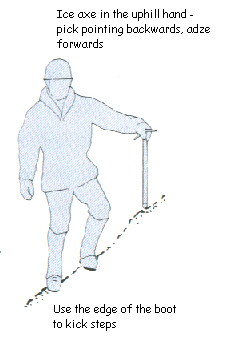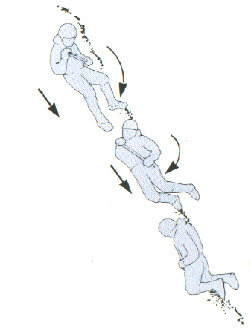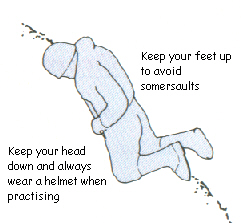
Winter mountaineering - some basic essentials

The most common cause of winter mountaineering accidents is a simple slip. Most people injured are well equipped and experienced, but they are not adequately prepared for the conditions they encounter. Although the mountains of Scotland are small when compared with the Alps or the Himalaya, they must be treated with the greatest of respect - especially in hard and icy winter conditions.
Of all the equipment used by the winter mountaineer, ice axe and crampons are the most important. Not only should you always take them with you when venturing on to snow covered terrain, you must also be able to use them expertly and confidently. As most winter deaths in the hills result from head injuries, it is recommended that you also wear a helmet.
Use of the ice axe
An ice axe is the basic piece of equipment needed for moving on snow and ice. It can be used as an aid to balance, for support, for purchase when climbing, for digging and step cutting and as an emergency brake. The choices of axes available is enormous. But one of between 50 and 70cm is suitable for general mountaineering. Axes with long shafts are more suitable for walking while short axes are designed for climbing.
Holding the axe
The axe should be carried in the uphill hand with the pick pointing backwards. This allows it to be used for support and balance and it is also the best position should it be needed as an emergency brake. Make sure your axe has a wrist strap and ensure this is worn at all times to prevent accidental loss.
Self arrest

Self arrest, or ice axe braking, are names given to the technique used to stop a slide. If you are prepared and have practiced using your ice axe, it is possible to stop a slide even on very hard snow. The following method is based on the basic ice axe holding position as described above. In the event of a slip, the adze of the axe (the wide shovel-like end) is positioned under your shoulder so that the pick can be applied to the snow slope, with the axe shaft braced across your body. Your feet should be raised so that your toes don't catch in the snow causing you to somersault. Roll on to your side and push the pick of the ice axe into the snow. Continue to roll your body over so you are facing the slope and your shoulder is applying downward pressure on to the axe so it digs into the snow. Keep your head down. Only experience will allow you to judge the amount of pressure you need apply to the pick - too little and you won't stop, too much and you risk losing the axe. For ice axe braking to be effective it must be practiced regularly, until it becomes an automatic reaction. When practicing, choose a slope with a safe run-off and no protruding rocks. Avoid slopes of over 40 degrees or whose run-off cannot be seen. Always wear a helmet when practicing and cover the spike at the base of the axe shaft to prevent accidental injury.

Movement on snow
When ascending snow slopes choose a zig-zag route which links patches of soft snow or areas of easier angle. Remember to always carry your axe in your uphill hand and move methodically and rhythmically, avoiding spurts and stops which lead to poor balance and stability. As you place your feet, use the edges of your boot sole to kick a small step to stand on. Using the edge of the boot is less tiring than using the toes. It is essential that your boots are sturdy and have stiff soles. If you can flex the boot sole in your hands it is too soft for winter use. Pay particular attention when changing direction, and try to plant the ice axe firmly in the snow for each step. Always have two points of contact with the snow slope - either both feet (when you move the axe) or one foot and the axe (as you take a step).
Use of crampons
When the snow becomes too steep or hard for step kicking, crampons should be worn. These should be fitted according to the manufacturer's instructions and must be the correct size and fit for your boots. A great many accidents occur as a direct result of badly fitted crampons coming loose or falling off. When walking in crampons avoid baggy or loose trousers on which they can snag and beware of anything hanging down from your waist. Try to adopt a gait which has the legs farther apart than normal, and again practice using your crampons in a safe, controlled environment. You should also flex your ankles so that all of the downward points bite. Avoid stamping or dragging your feet. Instead develop the technique of placing them firmly and confidently with each step. An occasional hard tap with the ice axe shaft will loosen any snow which has gathered and compacted under the boot sole.
Important points to remember
- Have the correct equipment and know how to use it
- Never venture where the snow lies without ice axe and crampons
- Be realistic about your experience and set your objectives accordingly
- Carry your ice axe in your hand - it is no good strapped to the back of your rucksack
- Wear a helmet
- Know how to navigate with map and compass and always leave details of your route with a responsible person who can raise the alarm should you fail to return
- Equipment is no substitute for practice and good judgement
- Consider doing a winter skills course before venturing out by yourself. Contact the Scottish Sports Council or Mountaineering Council of Scotland for information (contact details can be found on out Links page